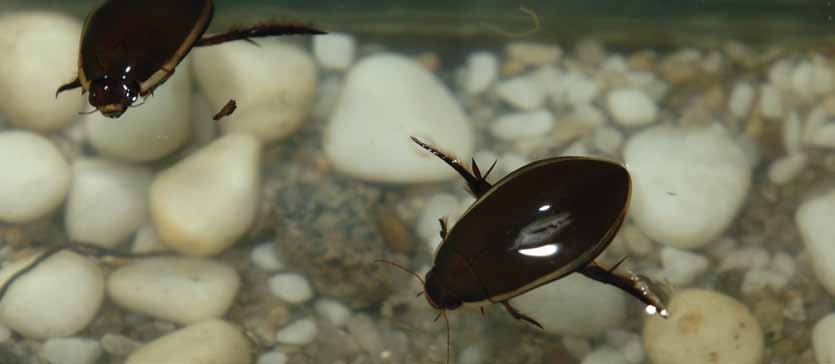Year of the Beetle
The world of the beetle doesn’t end where the land meets the water. Among the more than 300,000 different species worldwide, many beetles have evolved to live their entire lives on or under the water.
One of the most commonly recognized in these parts is the aptly named whirligig beetle. These thumbtack-sized, shiny black bundles of energy are found all over quiet ponds, river eddies and sheltered lake coves. As they skim across the surface tension of the water, they search for prey both on top of and underneath the surface. They accomplish this feat with the unusual arrangement of two sets of eyes; one that sits above and one below the water, constantly search for predators and prey as the beetles whirl in endless circles across the surface.
Predacious diving beetles are strong swimmers and powerful predators. With a smooth, streamlined carapace and back legs shaped liked paddles, the diving beetle can catch and consume tadpoles, other aquatic insects and even small fish. Although aquatic beetles spend most of their time underwater, they must occasionally come to the surface to breath air. A predacious diving beetle rises to the surface every 2-10 minutes to extend the tip of its abdomen out of the water to take in a breath like a swimmer might do through a snorkel. The air is stored as a bubble, tucked between the wing casings and the soft body surface.
As winter fast approaches, aquatic beetles will go into a state of hibernation to survive the cold. Some will lie dormant at the bottom or in a burrow underneath the water. Here in the Southeast, it is possible for the beetles to surface for oxygen on warm sunny days, but otherwise they are quite capable of existing for months without food and very little air.
And so The Year of the Beetle ends. Hopefully you’ve learned something new about these amazingly diverse insects over the course of the year. Perhaps a new curiosity or appreciation has taken hold. The natural world is an incredible place with infinite possibilities for learning. If beetles are your thing, go for it. If plants get you out of bed in the morning, the more power to you. If birdwatching is your passion, pursue it with everything you’ve got.
Or maybe, just maybe, you haven’t found your spark yet. Maybe next year’s focus on nature will set you on your path. To find out what that might be, stay tuned.

